SaaS, delivering applications seamlessly over the Internet, coupled with multi-tenant SaaS architecture, unlocks the power of resource sharing for swifter and more efficient scaling. This synergy optimizes public cloud utilization, consolidates resources, and democratizes cloud access, rendering it both affordable and consistent for businesses of all sizes, from nimble startups to industry giants.
If you're navigating the terrain of multi-tenancy, wondering about its essence, and pondering its application in your business, you've arrived at the perfect juncture. In this article, we explore multi-tenant SaaS application development and guide you to choose the ideal architecture that aligns seamlessly with your business goals.
Key takeaways
- For companies prioritizing high levels of customization, control, and data isolation, single-tenant architecture offers dedicated resources, enhancing performance stability and security.
- Multi-tenant SaaS architecture stands out for its cost efficiency, seamless scalability, and rapid deployment capabilities, making it an ideal choice for businesses looking to optimize software infrastructure for growth.
- After selecting an architecture, the focus shifts to implementing tenant isolation strategies (for multi-tenant) or optimizing resource allocation (for single-tenant), ensuring the architecture aligns with business objectives.
- Tenant isolation strategy includes silo isolation, pool isolation, bridge model, and tier-based isolation. The choice depends on the specific needs for security, resource efficiency, and collaboration among tenants.
- The multi-tenant SaaS architecture development process encompasses analyzing requirements, designing a scalable and secure system, custom development, thorough testing for reliability, scalable deployment, and ongoing maintenance, all while engaging in continuous feedback loops with tenants for iterative improvement.
Multi-tenant vs. single tenant architecture
| Aspect | Multi-Tenant Architecture | Single-Tenant Architecture |
|---|---|---|
| Flexibility | Supports shared customization and feature enhancements | Offers high levels of customization and control |
| Resource Allocation | Efficiently shares resources among tenants, reducing overall costs | Incurs higher costs due to dedicated resources per tenant |
| Scalability | Facilitates seamless scaling of resources with tenant growth | Limited scalability tied to dedicated resources per tenant |
| Data Isolation | Requires robust mechanisms to ensure privacy and security | Provides complete data isolation and control for each tenant |
| Maintenance Efficiency | Allows simultaneous application of updates and maintenance to tenants | Requires individual application of maintenance to each tenant |
| Performance Stability | May experience impact on performance due to shared resources | Ensures improved performance and stability with dedicated resources |
Single tenant
In a single tenant architecture, a dedicated instance of the software and its supporting infrastructure is assigned to serve a single customer. Each customer has an independent multi-tenant database and a distinct software instance, with no resource sharing.
Pros of single tenant:
- Security: Enhanced security with dedicated hardware and limited access.
- Dependability: Abundant resources dedicated to a single client, ensuring reliability.
- Customization: Full control over the environment allows for tailored solutions and added functionalities.
Cons of single tenant:
- Maintenance: Requires more tasks and regular maintenance for smooth operation.
- Setup/Management: Longer setup and management times compared to multi-tenant environments.
- Cost: Premium price due to exclusive resources allocated for a single customer.
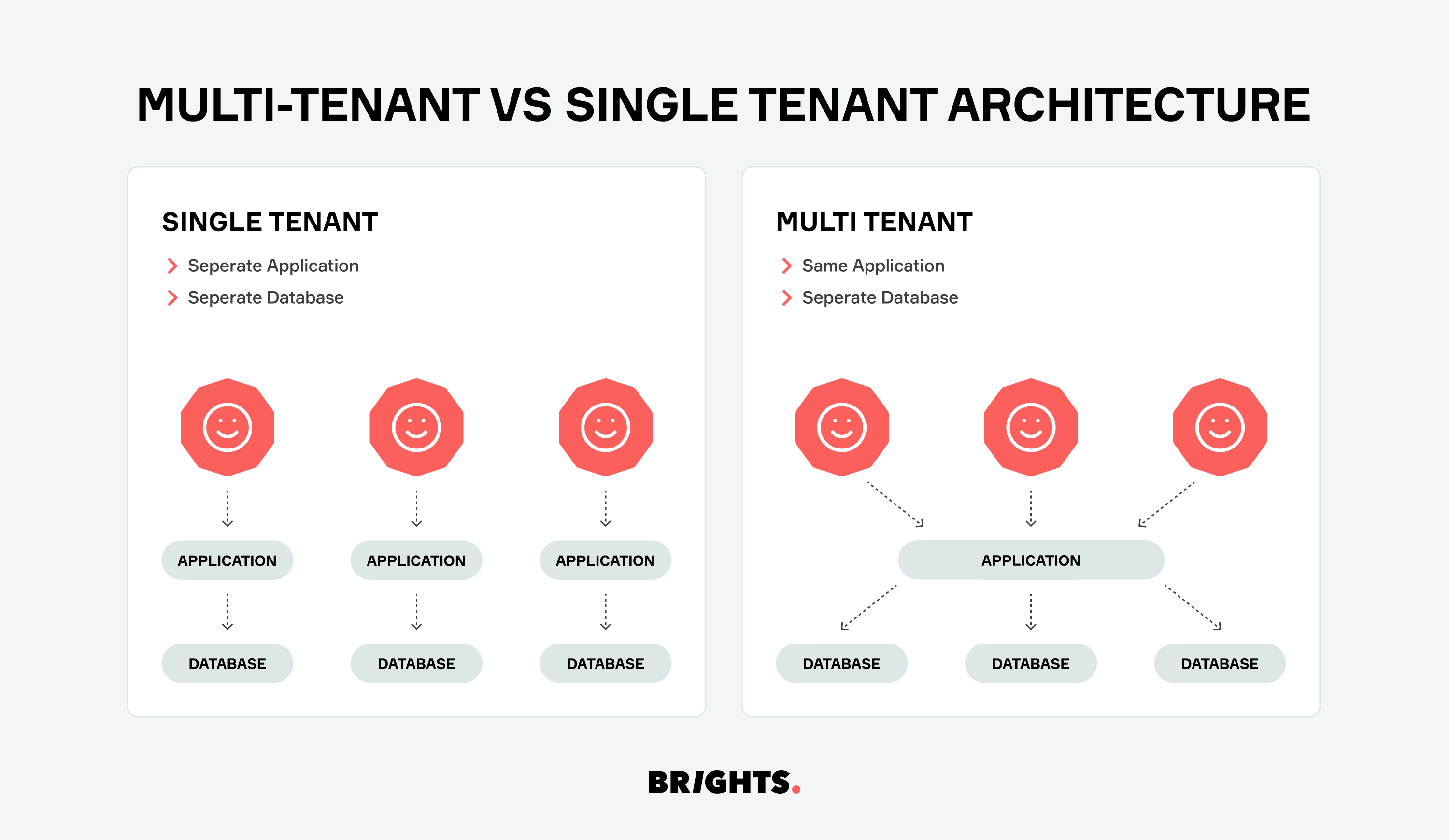
Multi-tenant
Multi-tenant SaaS architecture involves a single instance of the software and its supporting infrastructure serving multiple customers. Customers share the software application and a common database, while each tenant's data remains isolated and invisible to others.
Pros of multi-tenant:
- Affordable Cost: Cost-sharing among multiple customers leads to more budget-friendly software.
- Integrations: Easier integration with other applications through the use of APIs.
- "Hands-free" Maintenance: The software as a service vendor handles a certain level of database maintenance.
Cons of multi-tenant:
- Limited Management/Customization: Restricted options for custom changes to the database.
- Security: Broader access for multiple users on the same database may reduce control over security.
- Updates/Changes: Changes in one part of the multi-tenant environment can impact interconnected applications, causing issues with integrations.
In choosing between single tenant and multi-tenant cloud architectures, businesses need to weigh factors such as customization needs, control preferences, and budget constraints to determine the most suitable solution for their unique requirements.
The business value of multi-tenant architecture
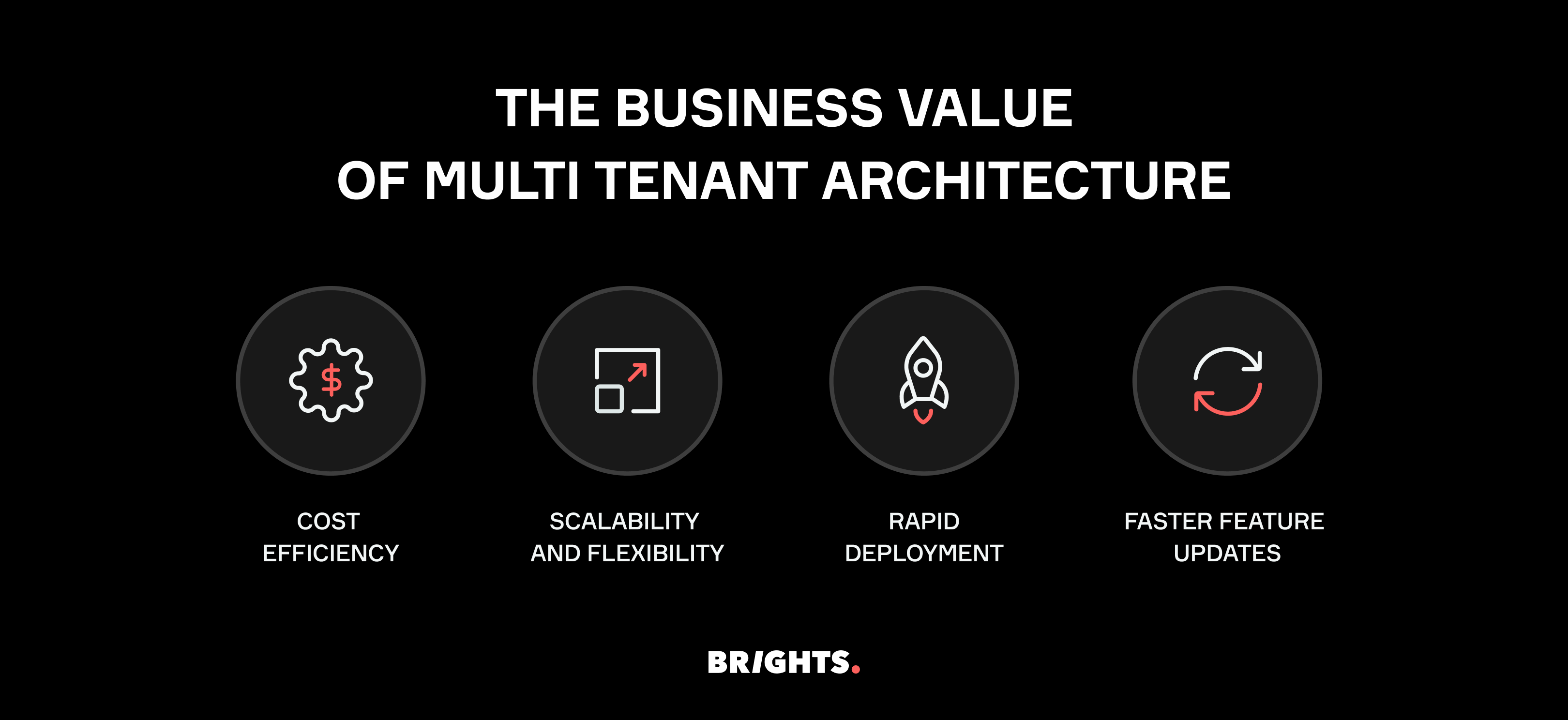
Cost efficiency
Since the application serves multiple tenants, the costs associated with infrastructure, maintenance, and software updates are spread across all customers. This significantly reduces the per-tenant cost of services.
Scalability and flexibility
Multi-tenancy facilitates faster and more efficient scaling of resources. As the user base grows, the architecture can easily accommodate increased demand without the need for extensive reconfiguration. This scalability ensures that businesses can adapt to changing requirements, whether it involves accommodating more users or handling larger volumes of data.
Rapid deployment
Multi-tenant environments are known for their speed of setup and management. Businesses can swiftly deploy their applications without the need for extensive customization or configuration. This rapid deployment is particularly advantageous for startups and enterprises aiming to bring their products to market quickly, gaining a competitive edge and responding promptly to market demands.
Faster feature updates
In a multi-tenant environment, when new features or updates are introduced, they benefit all users simultaneously. This ensures that every tenant has access to the latest advancements without the need for individual upgrades. The shared nature of updates contributes to a more standardized and consistently improved user experience across the entire user base.
In summary, these advantages position multi-tenancy as a strategic choice for businesses aiming to optimize their software infrastructure for efficiency, growth, and competitiveness in the dynamic digital landscape.
Models and use cases of multi-tenant architectures
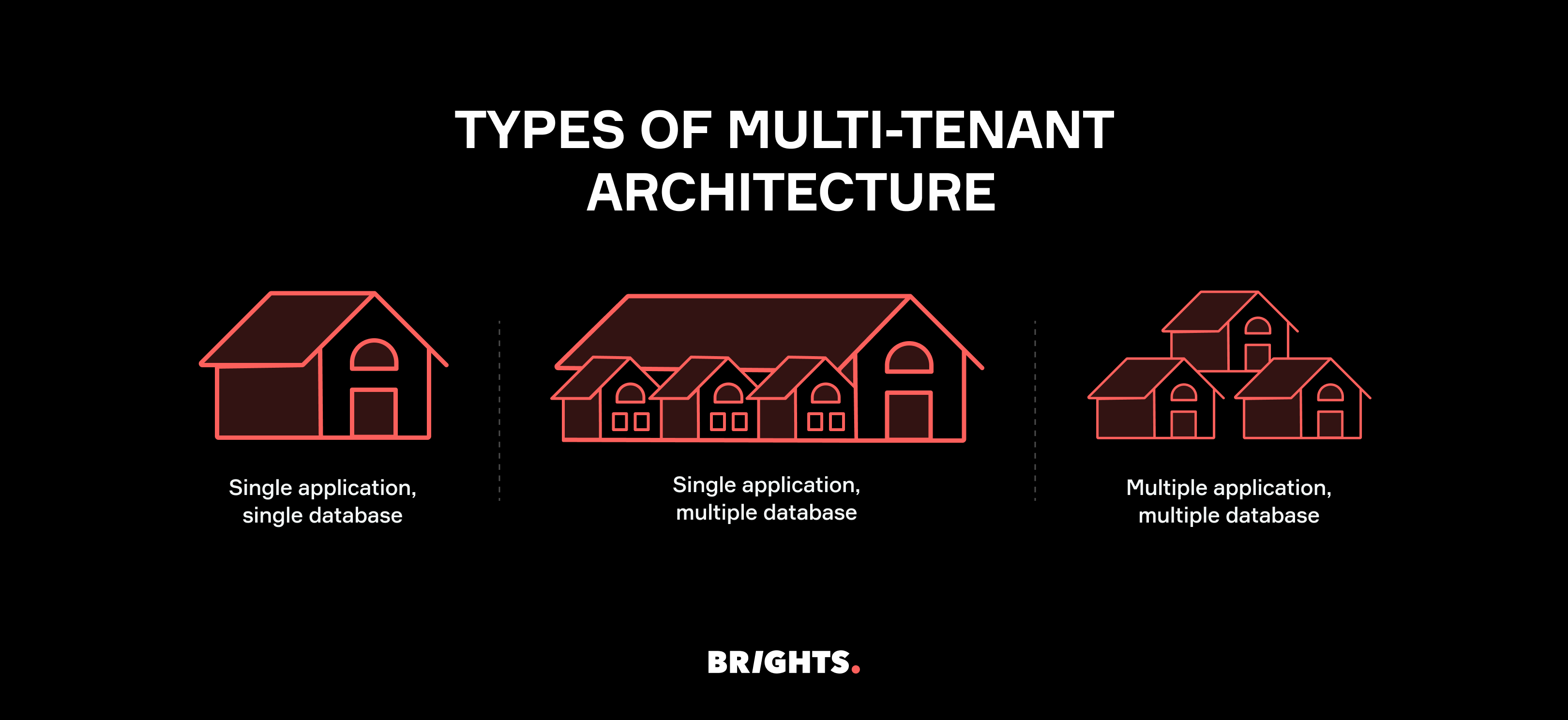
Single application, single database
In this architecture, a single application serves multiple tenants, each with its dedicated database. This model ensures a high degree of data isolation, as each tenant's information is stored separately while sharing the same application framework. This approach offers heightened security and customization for individual tenants within a unified application. For instance, in a cloud-based Customer Relationship Management (CRM) platform, each company subscribing to the service has its isolated database, maintaining data integrity and security.
Single application, multiple databases
Contrasting the previous model, this architecture involves a single application with multiple databases. Tenants still share the same set of application features, but each has its own distinct database. This strikes a balance between resource efficiency and data separation. Consider a content management system where various clients manage their content within a shared platform but maintain exclusive databases for enhanced data control and flexibility.
Multiple applications, multiple databases
Expanding the scope further, this multitenant architecture incorporates multiple applications and multiple databases. Each application serves a specific business function, and tenants can choose the applications that best suit their needs. This offers unparalleled flexibility and scalability, allowing businesses to tailor their application landscapes to accommodate diverse business units or functions. For instance, a comprehensive enterprise resource planning (ERP) system might include modules for finance, human resources, and logistics, with each module serving as an independent application with its dedicated database.
Types of storage realization in multi-tenant architecture
In multi-tenant architectures, ensuring effective tenant isolation is crucial for maintaining security, privacy, and performance. Various strategies exist to achieve this goal, each tailored to meet specific requirements. Here, we explore four notable tenant isolation models: silo isolation, pool isolation, bridge model, and tier-based isolation.
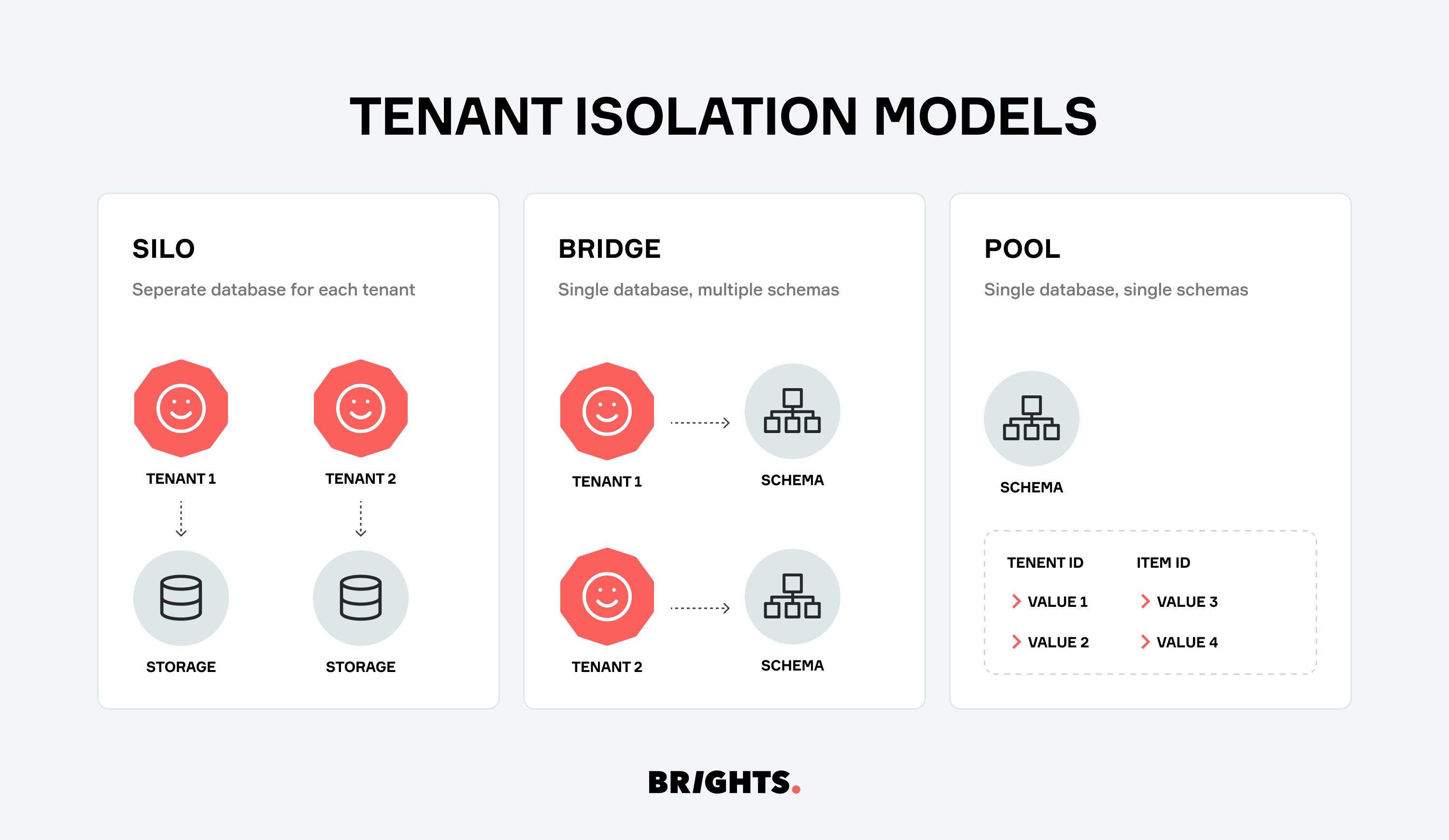
Silo isolation
In the silo isolation model, each tenant operates within its isolated environment, akin to a silo. This means that tenant data, resources, and processes are completely segregated from one another. While this approach provides robust security and privacy, it may lead to underutilization of resources as each tenant has a dedicated infrastructure. Silo isolation is often suitable for scenarios where stringent data separation and security are top priorities, such as in financial institutions or healthcare systems.
Pool isolation
Contrasting silo isolation, the pool isolation model pools resources shared by multiple tenants. While tenants still maintain separate databases, they share a common pool of resources such as computing power and storage. This approach optimizes resource utilization and is more cost-effective but requires robust mechanisms to ensure data isolation and security. Pool isolation is suitable for scenarios where tenants' needs are similar, and efficiency in resource allocation is critical.
Bridge model
The bridge model strikes a balance between complete isolation and resource sharing. It involves the creation of a "bridge" that allows controlled communication between tenants. This model enables tenants to share specific resources or data selectively, promoting collaboration while maintaining a level of isolation. The bridge model is valuable in scenarios where some level of cooperation between tenants is beneficial, such as in collaborative research environments or industry ecosystems.
Tier-based isolation
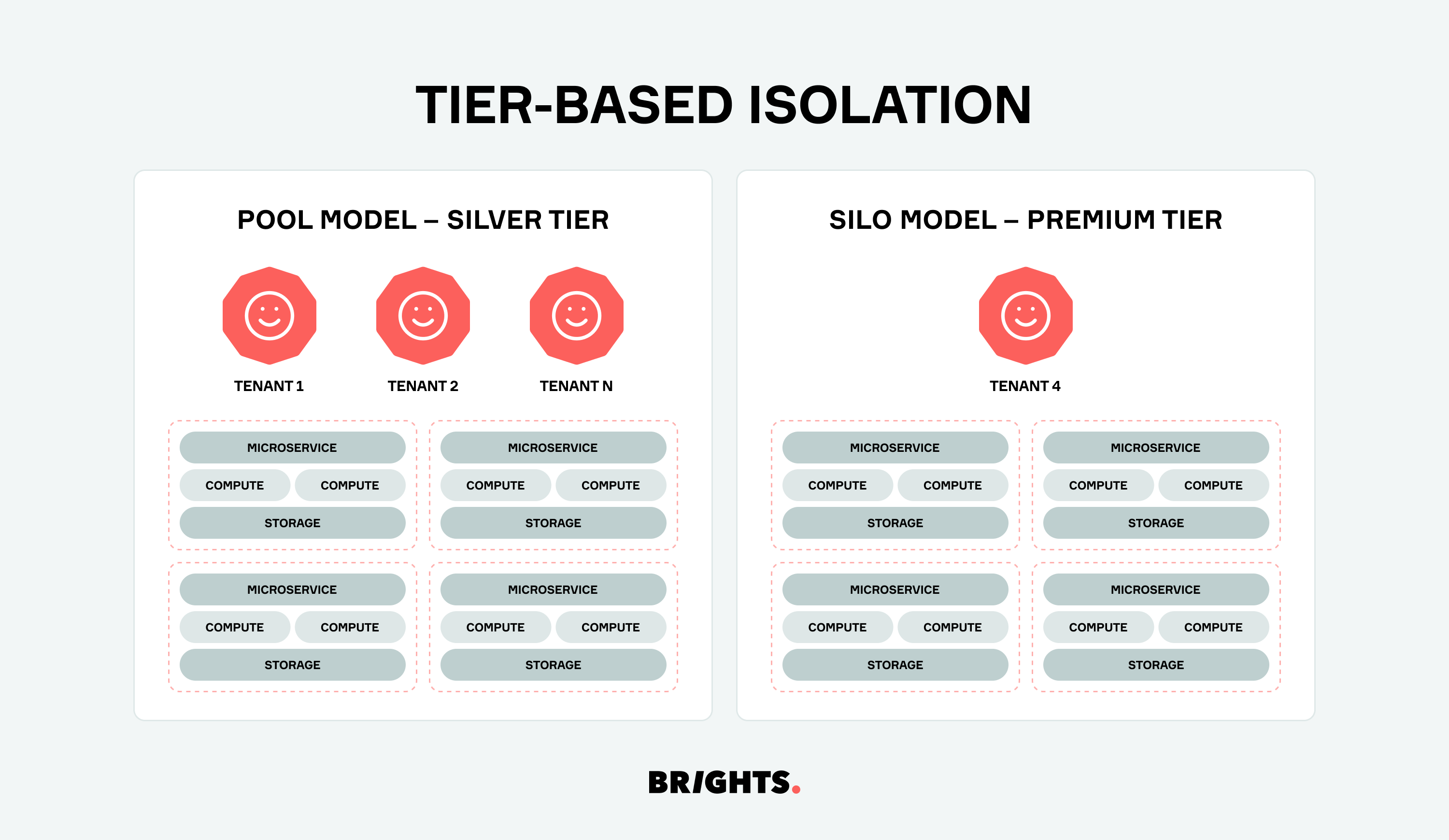
In this type of isolation, tenants are categorized into different tiers based on specific criteria, such as usage patterns, sensitivity of data, or performance requirements. Each tier is allocated different levels of resources and access privileges. This model allows for a more nuanced approach to tenant isolation, tailoring resource allocation and security measures based on the specific needs of each tier. Tier-based isolation is advantageous in environments where tenants have varying requirements, allowing for more efficient use of resources.
In conclusion, the choice of a tenant isolation strategy depends on the specific needs and priorities of the multi-tenant application. Whether opting for strict siloed isolation, resource-efficient pooling, a balanced bridge model, or tier-based customization, each approach has its merits in addressing the intricate balance between security, resource utilization, and collaboration within a multitenant architecture.
Multi-tenant SaaS application development process
Drawing from our extensive expertise in building multi-tenant SaaS applications, we offer insights into the meticulous process that underpins the creation of these sophisticated, scalable products. Crafting a successful multi-tenant SaaS applications demands a comprehensive understanding of not only the technical intricacies but also the unique challenges and considerations inherent in serving multiple users with distinct needs. Our experience guides the following steps, ensuring a seamless development journey that maximizes efficiency, functionality, and user satisfaction.
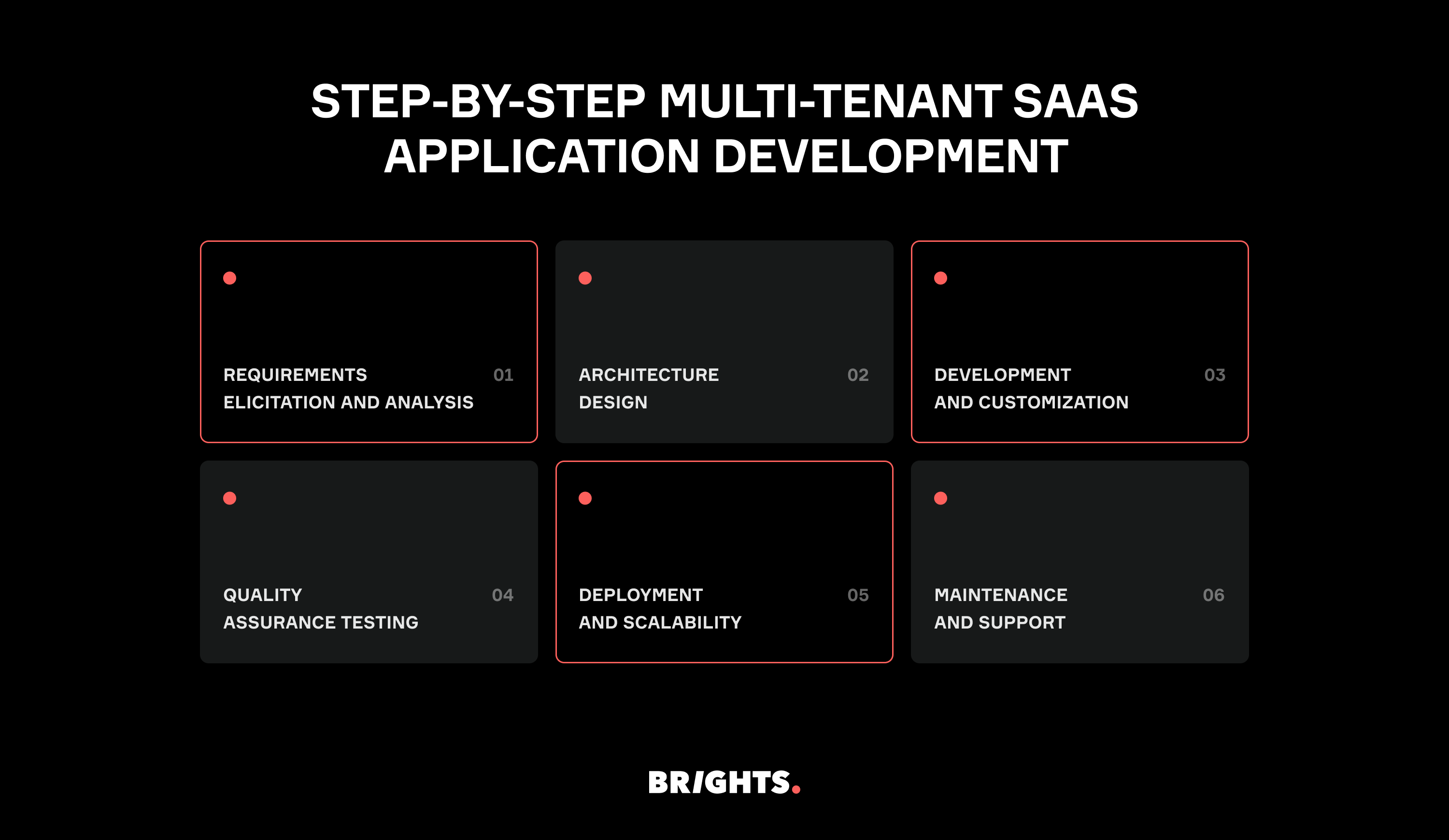
1. Requirements elicitation and analysis
Commencing with a meticulous analysis of client needs and industry nuances, the process begins with a detailed exploration of requirements. We engage in comprehensive discussions to understand unique features, scalability demands, and customization preferences for each tenant. This phase serves as the foundation for tailoring the SaaS application to meet the diverse demands of multiple users.
2. Architecture design
The development journey proceeds to design a robust architecture tailored for the multi-tenant nature of the application. Decisions regarding database structures, resource-sharing mechanisms, and security protocols are pivotal. Crafting a scalable and efficient framework ensures optimal performance, data isolation, and user privacy, setting the stage for the subsequent development phases.
3. Development and customization
The development phase involves coding the application in alignment with the meticulously designed architecture. Emphasizing a modular design, our approach facilitates easy customization to meet the specific needs of individual tenants. Each tenant benefits from tailored features and configurations, ensuring a personalized experience within the shared SaaS ecosystem.
4. Quality assurance testing
Rigorous testing is integral to guarantee the stability, security, and functionality of the multi-tenant SaaS application. Our quality assurance process includes testing for data integrity, security vulnerabilities, and performance across diverse usage scenarios. This meticulous testing approach ensures that the application meets the varied needs of tenants without compromising on reliability.
5. Deployment and scalability
Following testing, the application is deployed in a scalable environment, ready to accommodate a varying number of tenants. Scalability is a core consideration, allowing the SaaS application to grow seamlessly with an expanding user base. This ensures that the system can handle additional tenants without compromising on performance, fostering long-term sustainability.
6. Maintenance and support
An integral aspect of our development process is the strategic approach to maintenance and support. Post-deployment, we provide ongoing maintenance and support services, ensuring that the SaaS application remains robust, secure, and up-to-date. Regular updates, bug fixes, and proactive monitoring contribute to the long-term success of the application, providing tenants with a reliable and continuously optimized user experience.
Our approach extends beyond a one-size-fits-all mentality. We understand that each business case is unique, and selecting the most appropriate multi-tenant SaaS model is paramount.
Brights SaaS architecture expertise
At Brights, our expertise in multi-tenant SaaS applications development is exemplified through the successful implementation of the Trust project. Trust was designed to empower enterprises seeking precise control over goods movement, and we strategically chose the Silo Isolation model to ensure the utmost security and confidentiality for each tenant.
In the silo isolation model, we established a distinctive environment for each tenant, resembling individual silos. This meticulous separation ensures that tenant data, resources, and processes exist in isolated realms, prioritizing security and confidentiality. Given that each tenant in Trust operates as a competitor, safeguarding their data became paramount.
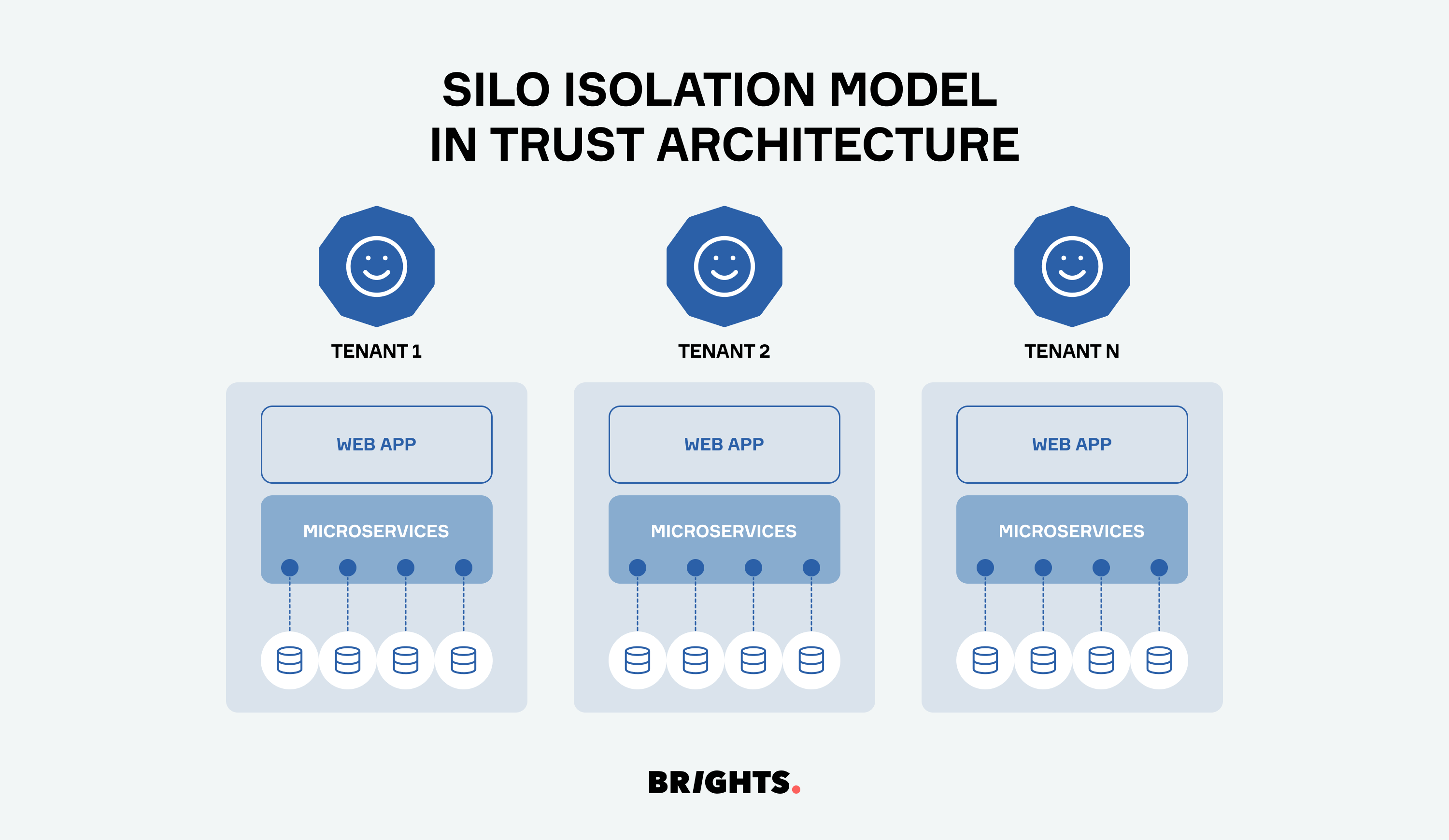
Wrapping up
For those embarking on the journey of SaaS application development, the key lies not just in understanding the intricacies of multi-tenancy but in choosing a partner with the expertise to harness its full potential. At Brights, our commitment to SaaS architecture excellence is more than a service — it's a transformative journey. From inception to ongoing support, our services are crafted to empower businesses, offering not just applications but gateways to sustained success.
